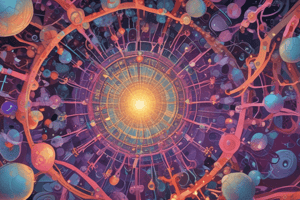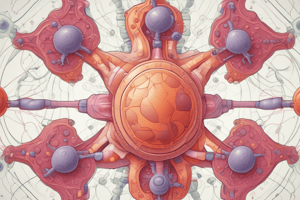Podcast
Questions and Answers
What type of immune system are antibodies a part of?
What type of immune system are antibodies a part of?
adaptive immune system
What are the three types of antigen recognition molecules?
What are the three types of antigen recognition molecules?
B Cell (antibody or immunoglobulin), T-Cell (T-cell receptor), All Cells (Major Histocompatibility Complex)
Describe antigens.
Describe antigens.
Molecules and molecular epitopes that are targets of antibody and specific receptors on T and B cells.
Describe immunoglobulin.
Describe immunoglobulin.
What produces antibodies?
What produces antibodies?
Describe immunoglobulin structure.
Describe immunoglobulin structure.
Describe the Fab component of Ig.
Describe the Fab component of Ig.
Describe the Fc component of Ig.
Describe the Fc component of Ig.
How many isotypes of immunoglobulins exist, and what are they determined by?
How many isotypes of immunoglobulins exist, and what are they determined by?
Describe in descending order the concentration in normal human serum of immunoglobulins.
Describe in descending order the concentration in normal human serum of immunoglobulins.
Which immunoglobulin isotype is never soluble and always membrane-bound?
Which immunoglobulin isotype is never soluble and always membrane-bound?
What are the two classes of light chains, and describe their association with heavy chains.
What are the two classes of light chains, and describe their association with heavy chains.
Compare and contrast light classes vs heavy classes.
Compare and contrast light classes vs heavy classes.
Describe variable region.
Describe variable region.
Describe the structure of the Fab fragment.
Describe the structure of the Fab fragment.
Describe the structure of the Fc fragment.
Describe the structure of the Fc fragment.
Describe disulfide bonds in Ig structure.
Describe disulfide bonds in Ig structure.
Describe hypervariable regions/complementary determining region (CDRs).
Describe hypervariable regions/complementary determining region (CDRs).
Describe CDR3.
Describe CDR3.
What determines the immunoglobulin isotype?
What determines the immunoglobulin isotype?
Describe idiotypic differences among Igs.
Describe idiotypic differences among Igs.
Compare and contrast isotypic vs idiotypic differences.
Compare and contrast isotypic vs idiotypic differences.
What is the major Ig isotype in the serum?
What is the major Ig isotype in the serum?
Describe IgG.
Describe IgG.
Flashcards are hidden until you start studying
Study Notes
Antibodies and the Immune System
- Antibodies are part of the adaptive immune system.
- They serve as antigen recognition molecules along with B cells (antibody/immunoglobulin), T cells (T-cell receptor), and all cells (Major Histocompatibility Complex).
Antigens
- Antigens are molecules or epitopes that trigger antibody production and specific receptors on T and B cells, typically derived from foreign materials such as proteins and sugars.
Immunoglobulins Overview
- Immunoglobulin refers to all antibody molecules produced by B cells, which can exist in soluble or membrane-bound forms.
- They recognize specific epitopes on proteins, polysaccharides, lipids, or nucleic acids.
- Genetic rearrangement allows for the potential generation of over 10^9 distinct specificities.
Immunoglobulin Structure
- Immunoglobulins have a Y-shaped structure consisting of two light chains and two heavy chains containing immunoglobulin (Ig) domains.
- Each immunoglobulin molecule has a variable region and constant regions, contributing to their unique functions.
Fab and Fc Components
- The Fab (fragment antigen-binding) component has arms that adapt to bind a large number of antigens.
- The Fc (fragment crystallizable) component determines the biological activities of the antibody.
Immunoglobulin Isotypes
- There are five immunoglobulin isotypes, determined by the heavy chain type.
- The typical concentration hierarchy in human serum is: IgG > IgA > IgM > IgE > IgD (acronym: GAMED).
- IgD is unique as it is never soluble and is always membrane-bound.
Light and Heavy Chains
- There are two classes of light chains: kappa and lambda; they are identical in a single antibody (either 2 kappa or 2 lambda).
- Light chains can associate with any heavy chain, contrasting with five distinct heavy chain classes.
Variable Region and Antigen Binding
- Each chain's amino-terminus contains a variable region that forms the antigen-binding site, while the remaining domains are constant.
- The Fab fragment is essential for antigen binding and consists of both variable and constant domains.
Disulfide Bonds and Stability
- Intramolecular disulfide bonds in antibody structure help form Ig domains.
- Intermolecular disulfide bonds connect heavy and light chains, playing a crucial role in forming the hinge region.
Hypervariable Regions
- Hypervariable regions, or complementary determining regions (CDRs), are critical for specificity in antigen binding, especially CDR3, which shows the greatest variability.
Immunoglobulin Isotype Determinants
- The immunoglobulin isotype is determined by the primary amino acid sequence of the heavy chains.
Idiotypic Differences
- Differences among immunoglobulins are idiotypic, based on antigenic characteristics of the variable regions.
Comparing Isotypic and Idiotypic Differences
- Isotypic differences depend on the heavy chain type (e.g., IgG vs. IgA), while idiotypic differences are based on the variable regions of the chains (e.g., IgG1 vs. IgG2).
Major Immunoglobulin in Serum
- IgG is the predominant immunoglobulin isotype present in serum and plays key roles in immune responses.
- IgG activates the classical complement pathway, acts as an opsonin, is vital for secondary immune responses, crosses the placenta for neonatal immunity, and is crucial in antibody-dependent cell-mediated cytotoxicity.
Studying That Suits You
Use AI to generate personalized quizzes and flashcards to suit your learning preferences.




